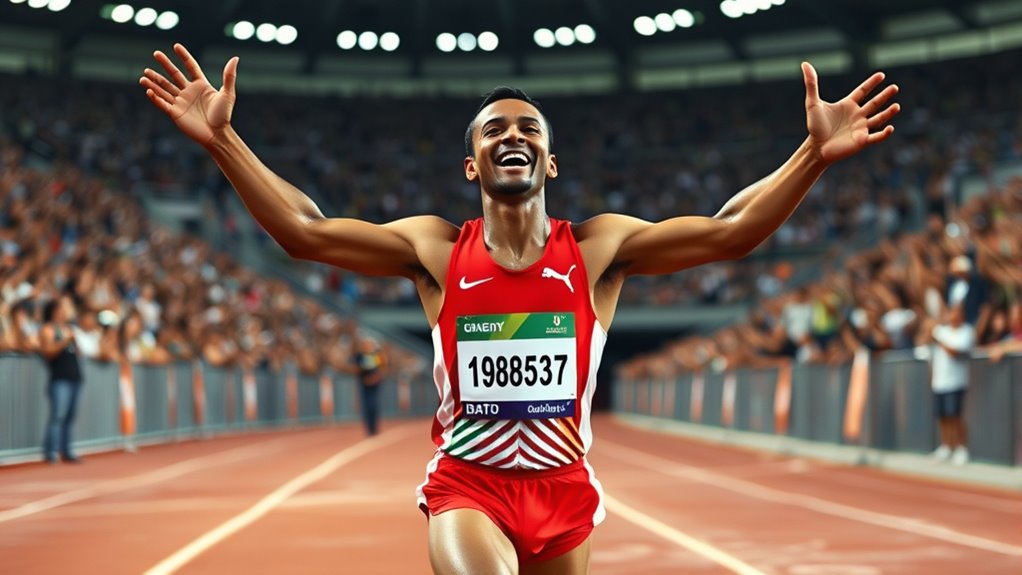As you follow the first sub-4-minute mile, you see runners line up, nerves and focus high. When the gun fires, they start strong, settling into a steady pace that pushes their limits. As fatigue sets in, mental toughness helps them overcome doubts. Near the final lap, they surge with everything they’ve got, culminating in Bannister’s historic finish. The moment changes sports forever, and the story continues to inspire—discover how each minute unfolded.
Key Takeaways
- The race began with runners adopting a steady pace, focusing on pacing, mental resilience, and strategic positioning.
- Mid-race, athletes faced exhaustion and doubts, relying on visualization, rhythm, and mental toughness to maintain momentum.
- As the final laps approached, runners pushed effort, maintained form, and visualized breaking the barrier.
- Roger Bannister surged in the last moments, crossing the finish line in under four minutes, shattering the record.
- The historic achievement transformed sports, inspiring future athletes and redefining human potential.
The Starting Line: Setting the Stage for History

Before that historic race, the world believed running a mile in under four minutes was nearly impossible. You knew that breaking this barrier required more than just physical strength; it demanded a focused athlete mindset. At the starting line, you carefully considered pacing strategies, understanding how every second would matter. You visualized the race, preparing your mind to stay calm and committed from the first step. Confidence and discipline fueled your resolve, knowing that the right mental approach could make the impossible achievable. You also understood the importance of high-performance equipment like specialized shoes and training aids, which could provide that extra edge. As you lined up, you felt a mix of nerves and determination, ready to push limits. That moment set the stage for history, where mental toughness and strategic pacing would prove essential in rewriting what athletes believed possible. Recognizing the significance of pacing strategies helped you stay focused on maintaining a consistent speed throughout the race. Additionally, understanding the role of training methods and proper preparation was crucial in reaching such a historic milestone.
The Early Miles: Establishing a Steady Pace

As the race begins, setting a steady pace early on becomes essential for success. Using effective pacing strategies helps you conserve energy and stay focused, preventing early burnout. You might feel enthusiastic or excited, but maintaining a consistent rhythm keeps your runner psychology strong—trusting your training and discipline. Concentrate on your breathing, stride, and cadence, avoiding the temptation to speed up too soon. This steady start allows you to build confidence and set a solid foundation for the later miles. Remember, rushing out too fast can undermine your goal, so stay calm and deliberate. Establishing a controlled pace from the beginning keeps your mind engaged and your body prepared for the challenge ahead, increasing your chances of hitting that historic sub-4-minute mark. Embracing mental resilience through imagination can also help you visualize success and stay motivated throughout the race. Additionally, understanding the importance of mental toughness can empower you to push through discomfort and maintain focus under pressure. Cultivating positive self-talk during the race can further reinforce your confidence and perseverance when faced with fatigue. Recognizing the significance of authenticity in training can also strengthen your commitment and mental clarity during the race.
Mid-Race Challenges: Confronting Physical and Mental Barriers

As you push through the middle of the race, physical exhaustion can threaten to slow you down. At the same time, mental doubt may creep in, making you question your ability to finish strong. Overcoming these barriers requires focus and resilience to keep your pace steady. Developing mental toughness and mental resilience is crucial for overcoming setbacks and maintaining your performance under pressure. Incorporating positive self-talk can help reinforce your confidence during these critical moments. Additionally, understanding your skin type and adjusting your tanning sessions accordingly can prevent overexposure and skin damage, ensuring you stay healthy while achieving that perfect tan.
Overcoming Physical Exhaustion
When fatigue sets in during a race, pushing through physical exhaustion becomes a critical test of mental resilience. You focus on breathing control, taking steady, deep breaths to supply your muscles with oxygen and reduce tension. Maintaining rhythmic breathing helps prevent your body from spiraling into panic or cramping. As your legs feel heavy and your energy wanes, you remind yourself of your training and inner strength. This mental resilience keeps you grounded, resisting the urge to slow down or give up. You concentrate on your form, your pace, and the finish line ahead. Every conscious breath fuels your determination, allowing you to overcome the physical toll and stay in the race. The mental toughness developed here is what separates the truly committed from those who falter.
Managing Mental Doubt
Mid-race, doubts can creep in, threatening your focus and confidence just when you need them most. To manage this, rely on mental resilience—reminding yourself of the training and preparation that got you here. Visualize success and recall moments of confidence building to reinforce your mindset. When negative thoughts surface, challenge them with facts: you’re capable, strong, and ready. Break the race into smaller segments, focusing on each stride instead of the entire mile. Breathe deeply to calm your mind, maintaining clarity under pressure. Trust your training and your ability to push through mental barriers. By staying present and resilient, you reinforce your confidence, transforming doubt into determination that propels you toward your goal.
Approaching the Final Lap: Building Momentum

With the final lap approaching, runners focus intensely on building their momentum to make a decisive push. You rely on your pacing strategy to conserve energy while increasing effort at the right moment. Mental resilience becomes vital as doubts may threaten your focus. Stay aware of your body’s signals and maintain a steady rhythm, knowing that this is the time to accelerate. Visualize your goal and draw strength from past training. The key is to keep your form tight and your mind locked on the finish line.
| Strategy | Mindset |
|---|---|
| Maintain consistent pace | Stay confident and focused |
| Accelerate gradually | Push through discomfort |
| Monitor energy levels | Visualize success |
The Last Stretch: Digging Deep for the Finish

As you enter the final stretch of the race, every ounce of effort counts more than ever. Your pacing strategy shifts from conserving energy to maximizing speed, pushing toward the limit. You focus on maintaining your rhythm, staying smooth despite the pounding in your legs. Mental resilience becomes your strongest tool—you remind yourself that this moment is what you’ve trained for, that giving up isn’t an option. You dig deep, drawing on every ounce of strength and determination. Your mind clears distractions, zeroing in on the finish line ahead. This is the final test of your stamina and focus. With each stride, you fight fatigue and doubt, knowing that victory lies just beyond this last push. This is the moment where persistence makes all the difference.
The Historic Break: Crossing the Line in Under Four Minutes

As you consider this historic moment, you can feel the tense anticipation from the race’s start, when every second counted. Breaking the record barrier changed athletic expectations forever, inspiring countless runners to push beyond limits. This achievement not only shattered a time barrier but also left a lasting impact on sports history.
The Race’s Tense Start
The tension in the stadium was palpable as the runners lined up for what would become history. You can feel the anticipation building, knowing that every decision in these first seconds matters. Their race strategy is clear: stay steady, conserve energy, then surge at the right moment. The crowd influence is electric, fueling the runners’ focus and determination. As the starter’s gun fires, the race begins with a burst of energy. You notice how the pack quickly forms, each athlete mindful of their position and pacing. The tension remains high, but the runners settle into a rhythm, aware that a careful start sets the stage for breaking the four-minute barrier. Every move counts in these initial moments, shaping the historic race to come.
Breaking the Record Barrier
When Roger Bannister crossed the finish line on May 6, 1954, he did more than just win a race; he shattered a seemingly insurmountable barrier by running the mile in under four minutes. His achievement proved that mental and physical limits could be pushed beyond perceived boundaries. To break this record barrier, athletes adopted innovative training techniques and strategic race plans.
Here are three key factors that made it possible:
- Optimized training techniques – focused on speed, endurance, and mental resilience.
- Precise race strategies – pacing evenly and maintaining a strong, consistent rhythm.
- Mental preparation – visualizing success and overcoming psychological barriers.
These elements combined to turn the impossible into reality, inspiring generations of runners.
Impact on Athletic History
Roger Bannister’s achievement on that historic day not only shattered the four-minute mile barrier but also transformed the landscape of athletic competition. It pushed athletes and coaches to rethink training techniques, emphasizing mental preparation alongside physical conditioning. The milestone proved that mental barriers could be broken, inspiring a shift in athlete psychology—confidence and focus became as essential as stamina and speed. After Bannister’s run, record-breaking became more frequent, and athletes approached their training with a more scientific and psychological mindset. This breakthrough demonstrated that limits are often self-imposed, motivating future generations to challenge perceived boundaries. Ultimately, crossing that line under four minutes changed how athletes train, think, and compete, marking a new era in track and field history.
Immediate Reactions: The Impact of a Record Broken

News of the first sub-4-minute mile immediately sent shockwaves through the running world, igniting a mix of awe and disbelief among athletes, coaches, and spectators alike. You could feel the sudden shift in athlete psychology, inspiring new confidence and pushing boundaries. The record-breaking achievement also highlighted advances in record-breaking technology, making such feats seem more attainable.
Breaking the four-minute mile sparked awe, inspiring athletes and showcasing technological progress in running achievements.
Consider these reactions:
- Athletes felt motivated to challenge perceived limits, sparking a new era of ambition.
- Coaches analyzed strategies and training methods to replicate the success.
- Spectators experienced a surge of excitement, fueling the sport’s popularity.
This moment reshaped expectations, demonstrating how breakthroughs influence collective mindset and technological progress, setting the stage for future athletic innovations.
Legacy and Reflection: The Race’s Enduring Significance

The breaking of the four-minute mile didn’t just alter records; it transformed how you see human potential. It challenged the athlete’s mindset, proving that limits are often mental barriers waiting to be broken. The record’s significance extends beyond athletics—it symbolizes the power of perseverance and belief. This race inspired generations to push boundaries, showing that seemingly impossible achievements can become reality through determination and focus. It shifted the understanding of human capability, encouraging athletes to aim higher and think differently about their limits. Today, the sub-4-minute mile stands as a tribute to innovation, resilience, and the relentless pursuit of excellence. Its legacy continues to motivate both athletes and anyone endeavoring to surpass their own boundaries.
Frequently Asked Questions
How Did Roger Bannister Prepare Physically and Mentally for the Record Attempt?
You prepare for a record attempt by following a rigorous training regimen that builds your speed, endurance, and strength. Mental resilience is equally essential; you visualize success, stay focused, and push through doubts. You train consistently, monitor your progress, and adapt your workouts. This combination of physical preparation and mental toughness helps you stay motivated, confident, and ready to break barriers when the moment arrives.
What Was the Public and Media’s Initial Reaction to Bannister’S Achievement?
When you consider the public and media’s initial reaction to Bannister’s achievement, you see a mix of skepticism and amazement. Many media outlets were initially doubtful, questioning if it was truly possible, but the public was genuinely amazed and inspired. His accomplishment challenged existing beliefs about human limits, sparking widespread admiration and excitement, and ultimately changing perceptions of what athletes can achieve.
How Did This Race Influence Future Middle-Distance Running Strategies?
Imagine you’re a coach inspired by Bannister’s race, realizing that strategic race pacing and training innovations can push limits. His achievement prompted runners to optimize pacing strategies, focusing on consistent splits rather than fast starts. This shift led to more scientific training methods, emphasizing endurance and speed. As a result, future middle-distance runners adopted smarter race strategies, steadily breaking records and transforming competitive standards.
Were There Any Controversies or Doubts Surrounding the Record at the Time?
You might wonder if there were doubts about the legitimacy of the record or controversy over timing back then. At the time, some skeptics questioned whether Roger Bannister’s run truly broke the record, due to inconsistent timing methods and lack of electronic systems. While most accepted it as legitimate, these doubts fueled discussions and pushed for more precise timing, ultimately leading to improved standards in record verification.
How Has the Record Been Challenged or Broken Since Bannister’S Historic Run?
Imagine the record as a mountain summit, constantly challenged by climbers enthusiastic to ascend higher. Since Bannister’s historic run, athletes have pushed the limits through record progression, with many breaking and re-breaking the mile record. However, doping controversies have shadowed some attempts, casting doubt on their legitimacy. Despite these hurdles, the record continues to inspire, representing relentless human spirit and the ongoing quest for excellence.
Conclusion
As you witness that historic moment, you realize it’s more than just a record shattered. It’s a gentle whisper of human spirit pushing boundaries, a quiet reminder that even the most formidable horizons can be approached with determination. In crossing that invisible line, you see not just history made, but a soft awakening in us all—an invitation to believe in what might quietly become possible when courage leads the way.









